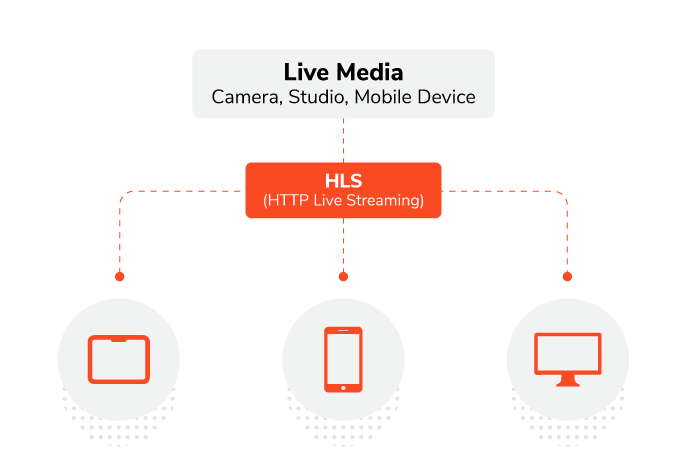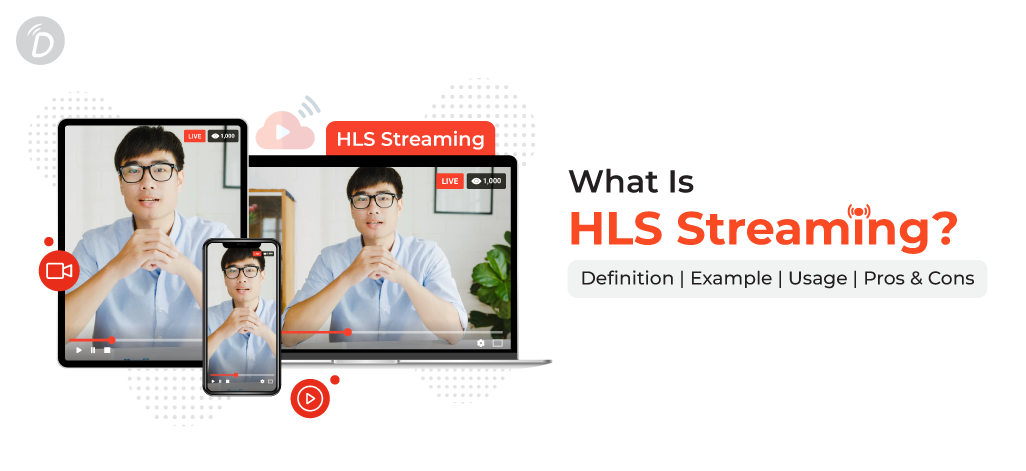HLS is a live streaming solution based on HTTP technology for safe and secure streaming. It involves a lot of benefits and higher success rates for the hosts. You may also want to learn and understand HTTP Live streaming. Then you are at the right place. This blog includes a complete guide to HSL, its working process, pros & cons, and an example that can help you know its effectiveness.
So, let’s begin without wasting another second.
An Overview of HLS Streaming
The full form of HLS is HTTP live streaming. You can count on it as the most trendy protocol to reach an enormous audience with tapped video and audio via the internet. However, you can use the HLS technology to press the video, split it into chunks, and transmit it over HTTP. Hence, your audiences can experience steady content streaming with HSL as it combines all the chopped pieces into a playlist.
If we talk in a more technical language, HSL is a protocol that compresses audio and video of video and transmits the entire stream using the MPEG-TS container format. Furthermore, the HTTP server creates M3U8 playlists, also called manifest files. It can be helpful in keeping all the diced videos enduring about 10 seconds in exact order.
There have been a lot of technologies just like HLS in the past. However, they were not successful. On the other hand, it even harmed a lot of users’ data. The programs like flash and QuickTime started showing update pop-ups with harmful malware that downloads as soon as the user clicks. Unfortunately, the hackers launched relentless attacks against such apps and software to take advantage of the videoes.
Then in 2009, Apple launched HLS, which is different as users do not need to download any app or software. They just need the device or browser that supports HLS streaming.
How Does HLS Streaming Work?

Let’s know a little more about the work process and reliability of HLS streaming on various platforms.
It depends on two software encoders and hosting platforms.
Encoders turn the broadcast into video files and audio files. It started with the camera capturing the event and then transmission. You can get the output into the MPEG file or transport stream.
You need a live streaming platform that can accept encoded video. It segments the data and places it on a server.
HLS is a perfect combination of the following segments:
- An audio and video Input from the camera
- Transformation by Encoding into the HEVC video and AC-3 audio.
- Receive the data with MPEG-4 file or MPEG-2 transport stream Output.
- Placing the short media files on the server with the help of Segmenting Tools.
- Indexing those short media files into an accurate sequence.
- The client accesses the stream after Publishing the index URL.
- Viewers can simply tap and get Access to files without a gap.
How Can You Use the HLS Streaming?
It is expected that whenever technology comes with something new, people think about why they need something else when they have one working fine. However, when Apple came up with the HLS video streaming, they faced antagonism and distrust from the developers. But with time, the HLS developed and became compatible with almost every other browser, including android and IOS.
Connect with the Industry's Most Experienced
Live Streaming Service Providers.

Hence, you can use HSL technology to share any kind of live video regardless of your program or device. Although games and other events are axiomatic, you can stream closely acquainted events, such as dinner parties, team outings, exhibitions, etc. So, you can make the people away from the event join in and enjoy with everyone.
What Are the Pros of Using HLS Streaming?
HSL Streaming is the best way to create qualitative broadcasting over various devices and browsers. You can find many benefits of HTTP live streaming that can be helpful in your sales and sharing information about your brand products and services.
1. Supports Video on Almost Every Device
The first advantage of HTTP live streaming is that you can use any browser or device to deliver your video. All the attendees can enjoy the live streaming by clicking on the invite link. It will divert the audiences directly to the compatible browser, and they can join and enjoy the whole event without hassle. Hence, there is no need to download any app or software to join and watch the event. Also, it is safer as the hackers won’t be able to add any pop-ups containing harmful malware. You can enjoy the event with any device, such as mobile, laptop, PC, tablet, and more.
HLS Supports Below Devices and Browsers
- All Google Chrome Browsers
- Safari
- Microsoft Edge
- iOS
- Android
- Linux
- Microsoft
- macOS
2. Dynamically Adjusted Video Quality
You will get the Adaptive Bitrate Streaming method as the HLS video format uses it. It can be helpful in measuring the internet speed of every device and adjusting the quality of video accordingly. Furthermore, you will reduce video lagging and buffering with the HLS technology. For instance, it does not matter whether you started watching the video with wifi, switched to the mobile network, and then connected to a public wifi network. You can endure a dynamic video quality as HSL adjusts it according to the Internet speed.
Connect with the Industry's Most Experienced
Live Streaming Service Providers.

3. Get Major Advantage in Affordable Price
One of the biggest advantages of HSL is its affordability. You can conduct an event regardless of device, browser, and media limitations. Depending on the load and other factors, it can make your broadcasting quality high without hassle. Hence, you can get the best quality and low-cost efficiency with HTTP live streaming.
4. 100% Safety and Security

As discussed above, apps and software face many challenges and cyber threats. However, you can conduct a safe and secure event with the HLS technology. It can make your event more secure with the web browser features.
What Are the Cons of Using HLS Streaming?
There are not many disadvantages of HLS as you can attain great success without these two issues. So, here are the two problems you may face during an HLS streaming.
1. Elapsed Time Between Live Streaming & View
The difference between the time of broadcasting and the audience’s view is called latency. It affects the streaming with late availability online. Furthermore, live streaming starts with recording, the HLS encoding process, transmission over the internet, server distribution, and then, at last, view decoding. This complete procedure may take a little time, which creates a difference between the recorded and telecasted videos.
2. Slow Internet Speeds

Most gamers and sports fans require live streaming to reduce the latency. However, the HSL creates a 20-60 seconds delay that does not matter in some events. It ultimately offers a viewer satisfaction or experience with safe & secure streaming. So, people with gaming or sports have to look for the right speed of the internet in order to create more beneficial broadcasting.
Solutions to These Problems
If you really care about the latency and internet speed issues, you must switch to the right live streaming services. They can offer you a great list of features that can be helpful in boosting the chance of reaching more people and making the event successful.
What Is the Top HLS Streaming Example?
You may have heard of the Roku College Basketball Streaming Madness. It is the best HLS streaming example to understand the efficiency of HLS. Hence, here is a detailed analysis of the event and the success rate.
- It grew 83% in the first round.
- Then it grew 97% in the second round.
- It attained 89% of the reach with the first and second rounds’ combination.
- It grew 91% on the analysis of hours streamed.
Hence, it proves that you can change a lot if you switch to HLS streaming. It can help you achieve great success without hassle.
Pivot to Live Streaming with Our Live Event Experts!
You can simply save yourself from numerous issues you may face during an HTTP live streaming. Just seek the help of the best live streaming platform, Dreamcast. We will provide you with countless features and functionalities that will change the complete broadcasting experience into a seamless and immersive experience for the users. Also, you will endure a tremendous boost in engagement, communication, and networking opportunities.
So, what are you waiting for? Get the best live streaming experience today with Dreamcast!
Connect with the Industry's Most Experienced
Live Streaming Service Providers.




















